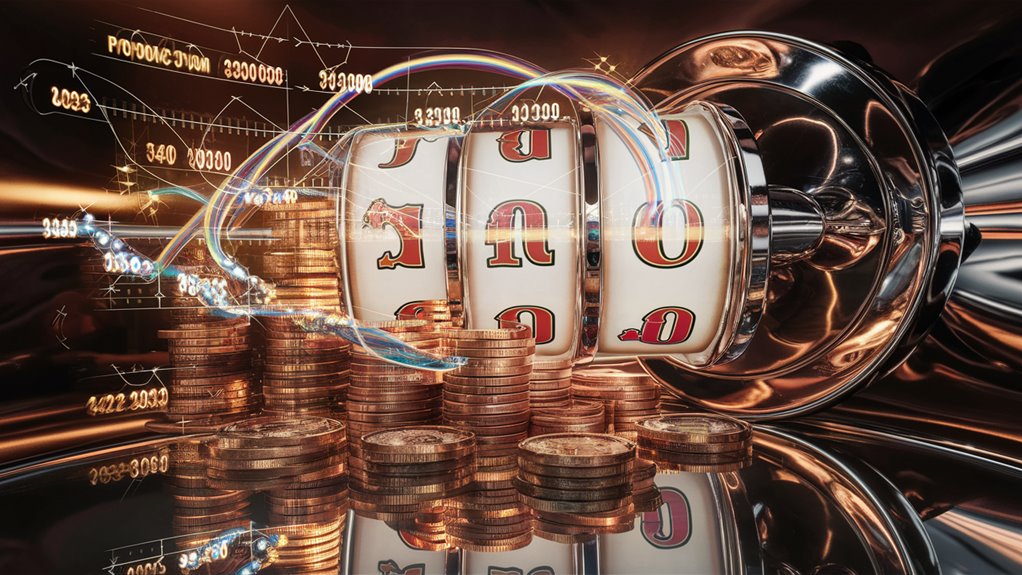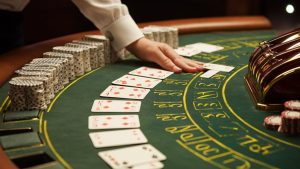
How to Understand Progressive Jackpots: Simple Math

Progressive jackpots are some of the most math-filled parts of gaming. They use 1-3% of each bet to add to a prize pool while keeping their own game payouts and house edge using math.
How They Work and the Math Behind Them
Modern systems that work together can handle 100+ gaming spots at once, using smart Mersenne Twister random number algorithms. They can work through 1,000 actions every second, sorting the math for over 100,000 possible outcomes.
How Much Players Get Back
There are two big parts in the math of progressive jackpots:
- Base game return-to-player: 88-92%
- Progressive extra: 3-6% more return
- Total possible return: about 94%
Playing Smart with High Risk
These jackpot systems have high risk, giving big but rare wins. To do well, you need:
- Smart timing when you bet
- Good handle of your total bets
- A good grasp of complex chance calculations
- Game Mechanics
- Knew the rates of jackpot builds
This math and careful play can help you get a better chance at a good return, playing within the rules of the game.
What Are Progressive Jackpots?
Knowing How Progressive Jackpots Work
The Basics of Progressive Jackpots
Progressive jackpot systems are based on detailed math.
1-3% of what you bet goes into a growing prize pool, keeping the rest for usual wins and the house edge.
How They Grow
A break down shows how a $1 slot machine game uses about $0.02 for the jackpot. With 100 active players doing 600 spins each hour, that’s $1,200 bet every hour, making $24 go to the jackpot each hour. This keeps going until someone wins it.
How Jackpots Are Structured
The starting amount plus growth from bets is how they set it up.
Casinos start with a set seed amount (often $10,000) while how much you bet decides how fast it grows. When someone wins the jackpot, it resets to this set amount and starts growing again.
Most times, you must bet the max – usually $3-5 each spin on $1 machines – to keep your chances.
Rates That Build The Prize
Slot Game Betting Rates and Prize Builds
How Jackpot Building Works
Betting rates decide how fast the jackpot grows, usually 1% to 5% of all bets.
The math ties closely – a 2% betting rate adds $2 to the prize for every $100 bet.
This buildup decides how fast the prize grows and how big it can get.
Connecting Systems for Bigger Prizes
Connected slot games speed up how fast the prize builds by putting together small amounts from many machines or places.
A normal setup has 100 connected machines, each used 400 times every hour at $1 per play with a 2% rate, gets $800 into the prize pool every hour.
This makes very big prizes worth millions in a few weeks through these small added bits.
Starting Amounts and Prize Setup
Starting jackpot values, or the seeds, set the lowest prize you can win.
These start values often go back to 25-50% of what is normal when someone wins it, keeping players interested by starting off with big possible wins.
Casinos cover these starting amounts themselves, and the ongoing betting rates refill the jackpot after each win.
Chance Work and Expected Worth
Getting How Jackpots and Value Work
Slot Math Analysis
Jackpot math needs smart stats to handle their changing prize sizes and how bets build them.
Focus is on two parts: the usual game return-to-player (RTP) and the extra jackpot part.
Working Out Expected Values
The math for these games looks at how often the jackpot is won – usually once in millions of tries – and adds up with the current jackpot size.
This with the usual game return gives the full expected value. Bigger jackpots slowly add more value, sometimes going over 100% to make good bet situations.
When It Breaks Even and Smart Timing
Most of the time, these slot games even out when jackpots are 3-4 times their starting amount.
At these points, the chance-weighted jackpot return balances out the usual house edge. But, the standard difference often is big, making big swings even when it looks good in theory.
Handling Your Betting Money
Even with good expected values, you need a big enough bankroll to handle natural ups and downs. Experts say smart bankroll handling is key to get past the big risk of losing a lot in these slots.
How Random Numbers Work
Knowing Random Number Creation in Slots

The Basics of RNG Systems
Modern slot games depend on smart random number creation (RNG) systems which are the base of every game result.
These use advanced Mersenne Twister formulas to make millions of numbers each second, no matter if a player is there or not.
How RNG is Set Up
The start of slot randomness is in pseudo-random number creators (PRNGs).
These use specific start values and complex math to make long number lines.
Each number matches to certain spots on the reels and game outcomes, working in big number ranges from 1 to several billion to keep patterns rare.
Real-Time Work and Independence
RNG results are truly on their own and work right away.
The system picks the right number when players hit the spin button.
These smart systems keep working:
- Non-stop at about 1,000 steps each second
- With each outcome not tied to the one before
- Following strict game rules
- Keeping number-making random to stop people guessing them
- Safe from tampering to keep play fair
Setting up these RNG basics makes sure everything is random and fair in slot games, with no chances for tricks or figuring out patterns.
Figuring Hit Chances
Getting How Often Wins Happen in Slots
Basic Hit Chance Math
Hit chances are a key math part in how slot games work.
This needed math finds the chance of getting winning sets in real play. The simple way splits the total winning sets by the all possible sets, shown as a percent.
Jackpot Hit Chances
Progressive slot games show different hit chances because of their big prizes and detailed payout setups.
While normal slots mostly have higher hit chances, progressive ones are in the 8-12% area due to their big jackpot options and complex payouts.
Chance Math Work
Understanding slot chance means looking at the multiplication rule.
For a normal three-reel progressive game with 64 symbols each, it makes 262,144 total sets (64 x 64 x 64). This math is the base for figuring out exact winning odds.
Hit Chances vs. RTP
Hit chances are much different from Return-to-Player (RTP) rates.
While hit chances measure how often you get winning sets, RTP looks at the expected returns over time. A 20% hit chance means you see winning sets about every fifth spin, but it doesn’t show how much or your long-term returns.
Deep Chance Thoughts
For deep chance checks, think about a machine with 100,000 possible sets. If 20,000 sets can win, this makes a 20% hit chance.
This gets harder with progressive jackpots, needing checks on many prize levels and symbol sets across different betting lines.
Getting Back to Player Rates
Getting How Return to Player (RTP) Works
Usual Game and Jackpot Parts
Return to Player (RTP) rates are key to seeing how slot games do and how much they give back.
Fully getting progressive jackpot slots means adding up the usual game return and the jackpot part.
Most times, usual games give an RTP from 88-92%, and jackpots add another 3-6% to the total.
Working Out Total RTP
The way to find total RTP is:
RTP(total) = RTP(base) + RTP(progressive)
For example, a slot game with a 90% base RTP and a 4% jackpot part ends up with a total RTP of 94%. This shows up over a long time, usually needing millions of spins to be sure.
Changing RTP in Progressive Jackpots
Progressive jackpots make a changing RTP scene where returns shift based on jackpot size.
The math shows that bigger jackpots link right to higher RTP rates.
When jackpots hit certain points, the total RTP can go over 100%, making good bet chances.
Smart Plays
Smart players keep an eye on jackpot levels, picking times for the best return chances.
This math way aims for certain 먹튀검증커뮤니티 jackpot points where the edge moves to the player’s side, showing the deep link between jackpot growth and best play times.
Game Risk and Checking It
Knowing Game Risk and Checking It in Progressives
Looking at Risk Numbers in Progressive Games
Risk numbers help see how progressive jackpot games do, linking how often you win and how much you get.
High-risk games give big but rare wins, while low-risk options give more regular, smaller wins.
Key Risk Points and Checking Them
Three big things set game risk:
- Variation in how much you win
- How often wins happen
- How much this changes
Progressive slot games often show high-risk signs, sometimes going over 300% in how much this changes.
This high risk asks for more careful bet handling to deal with possible losing times.
Smart Risk Checks and Handling Your Bets
Chance Checks
Deep risk checks involve figuring how likely getting to payout points is against what you need to spend.
Games with a 95% RTP usually need about 1,000 spins to match up with expected returns.
Picking Based on Risk
Match your how willing to take risks to the right risk numbers in games:
- If you don’t like risks: Pick lower risk progressive games
- If you’re okay with high risks: Try high-risk games
- If you spread risks: Keep high-risk game plays low unless you have lots of money
Handling your bets is key when facing big changes in winning and losing, especially in high-risk progressive games.
Keep smart limits on how much you bet and pick games based on what risks you can handle and how much money you have.


